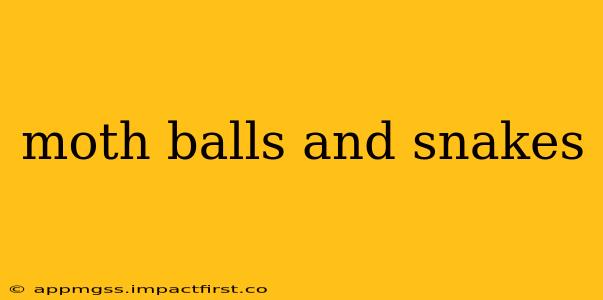Mothballs, those pungent white spheres found in closets and basements, and snakes, the slithering reptiles of the wild, might seem to have little in common. However, a surprising relationship exists between them, one that involves both attraction and repulsion, depending on the context. This article delves into the complex interplay between mothballs and snakes, exploring their interaction and the potential implications.
Are Mothballs Harmful to Snakes?
This is a crucial question, and the answer isn't a simple yes or no. The active ingredient in most mothballs is naphthalene or paradichlorobenzene, both of which are volatile organic compounds (VOCs). These compounds can be toxic to snakes, causing respiratory problems, neurological issues, and even death if ingested or inhaled in sufficient quantities. However, the severity depends on several factors:
- Concentration: A low concentration of mothball fumes might cause minor irritation, while high concentrations are far more dangerous.
- Species: Some snake species may be more sensitive than others to the chemicals in mothballs.
- Exposure time: Brief exposure is less likely to cause significant harm compared to prolonged exposure.
It's important to note that direct contact with mothballs is potentially more dangerous than simply being in the vicinity of mothball fumes. A snake might accidentally ingest a mothball, leading to serious consequences. Therefore, keeping mothballs out of reach of snakes is crucial.
Do Mothballs Repel Snakes?
While the toxicity of mothballs makes them a potential hazard for snakes, some people believe they act as a repellent. This belief is largely anecdotal, and there's no scientific evidence to conclusively support the claim that mothballs effectively repel snakes. Snakes have a sophisticated sense of smell, but their reaction to the strong odor of mothballs is unpredictable. Some might avoid the area due to the pungent smell, while others might be unaffected.
Therefore, relying solely on mothballs to keep snakes away is not a recommended strategy. More effective methods for snake control include removing attractants (like rodents), sealing entry points to your home, and employing professional snake removal services.
How to Keep Snakes Away from Your Home (Without Mothballs)
Several proven methods offer safer and more effective snake deterrence than using potentially harmful mothballs:
- Remove food sources: Snakes are attracted to areas with rodents, insects, and other prey. Keeping your property clean and free of debris will help minimize their attraction.
- Seal entry points: Examine your home's exterior for cracks, gaps, and holes that snakes might use to enter. Seal these openings with caulk or other suitable materials.
- Landscaping: Maintain a well-maintained lawn, trimming overgrown vegetation that provides snakes with shelter.
- Professional help: If you have a persistent snake problem, contact a qualified pest control professional experienced in snake removal.
Are Mothballs Safe Around Pets?
The toxicity of mothballs isn't limited to snakes. Mothballs are also dangerous to other pets, including dogs and cats. They can cause similar health problems as in snakes, including respiratory issues, neurological symptoms, and even death if ingested. Keep mothballs stored securely and out of reach of all animals.
What other methods can I use to keep snakes away?
Beyond the methods listed above, consider these additional strategies:
- Ultrasonic repellents: These devices emit high-frequency sounds that are purportedly unpleasant to snakes. The effectiveness varies, but some homeowners find them helpful.
- Natural repellents: Some essential oils, such as peppermint or cinnamon, are believed to repel snakes. However, more research is needed to confirm their efficacy.
- Chicken wire: Burying chicken wire around the perimeter of your property can act as a physical barrier, preventing snakes from burrowing under fences or walls.
Remember, the best approach to snake control is a multi-faceted one that combines several preventive measures rather than relying on a single method like mothballs. Prioritize safety and effectiveness when choosing your snake deterrence strategy.
